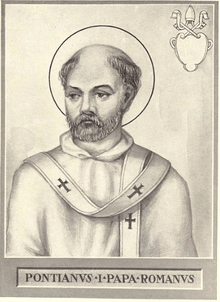Pope Pontian
| Pope Saint Pontian | |
|---|---|
 Imaginary portrait from Artaud de Montor The Lives and Times of the Popes, 1910 | |
| Papacy began | 21 July 230 |
| Papacy ended | 28 September 235 |
| Predecessor | Urban I |
| Successor | Anterus |
| Personal details | |
| Born | c. 200 |
| Died |
October 235 Sardinia, Roman Empire |
| Sainthood | |
| Feast day | 13 August |
Pope St. Pontian (Latin: Pontianus; died October 235), was the Bishop of Rome from 21 July 230 to 28 September 235.[1] In 235, during the persecution of Christians in the reign of the Emperor Maximinus the Thracian, Pontian was arrested and sent to the island of Sardinia. He resigned to make the election of a new pope possible.[1]
Biography
A little more is known of Pontian than his predecessors, apparently from a lost papal chronicle that was available to the compiler of the Liberian Catalogue of Bishops of Rome, written in the 4th century.
Pontian's pontificate was relatively peaceful under the reign of the Emperor Severus Alexander, and noted for the condemnation of Origen by a Roman synod, over which Pontian likely presided.[1] According to early church historian Eusebius of Caesarea, the next emperor, Maximinus, overturned his predecessor's policy of tolerance towards Christianity.[2] Both Pope Pontian and the Antipope Hippolytus of Rome were arrested and exiled to labor in the mines of Sardinia,[3] generally regarded as a death sentence.[4]
In light of his sentence, Pontian resigned as bishop on 28 September 235, so as to allow an orderly transition in the Church of Rome. This action ended a schism that had existed in the Roman Church for eighteen years. He was beaten to death with sticks.[3] Neither Hippolytus nor Pontian survived, reconciling with one another there before their deaths. Pontian died in October 235.[5]
Remembered
Pope Fabian had the bodies of both Pontian and Hippolytus brought back to Rome in 236 or 237 and buried in the papal crypt in the Catacomb of Callixtus on the Appian Way.[3][6] The slab covering his tomb was discovered in 1909. On it is inscribed in Greek: Ποντιανός Επίσκ (Pontianus Episk; in English Pontianus Bish). The inscription "Μάρτυρ", "MARTUR" had been added in another hand.
Pontian's feast day was previously celebrated on 19 November, but since 1969 both he and Hippolytus are commemorated jointly on 13 August.[7]
See also
Notes
- 1 2 3 Kirsch, Johann Peter (1911). "Pope St. Pontian" in The Catholic Encyclopedia. Vol. 12. New York: Robert Appleton Company.
- ↑ Papandrea, James L. (January 23, 2012). Reading the Early Church Fathers: From the Didache to Nicaea. Paulist Press. ISBN 978-0809147519.
- 1 2 3 Fr. Paolo O. Pirlo, SHMI (1997). "Sts. Pontian & Hippolytus". My First Book of Saints. Sons of Holy Mary Immaculate - Quality Catholic Publications. pp. 179–180. ISBN 971-91595-4-5.
- ↑ G. W. Clarke, "Some Victims of the Persecution of Maximinus Thrax," Historia: Zeitschrift für Alte Geschichte, Bd. 15, H. 4 (Nov., 1966): pp. 445-453, p. 451.
- ↑ Richard P. McBrien, Lives of the Popes (San Francisco: Harper Collins, 2000), 45.
- ↑ McBrien, Lives of the Popes, 45.
- ↑ Calendarium Romanum (Libreria Editrice Vaticana 1969), p. 146
References
-
 Herbermann, Charles, ed. (1913). "Pope St. Pontian". Catholic Encyclopedia. New York: Robert Appleton Company.
Herbermann, Charles, ed. (1913). "Pope St. Pontian". Catholic Encyclopedia. New York: Robert Appleton Company.
External links
| Wikimedia Commons has media related to Pope Pontian. |
| Titles of the Great Christian Church | ||
|---|---|---|
| Preceded by Urban I |
Bishop of Rome Pope 230–235 |
Succeeded by Anterus |

